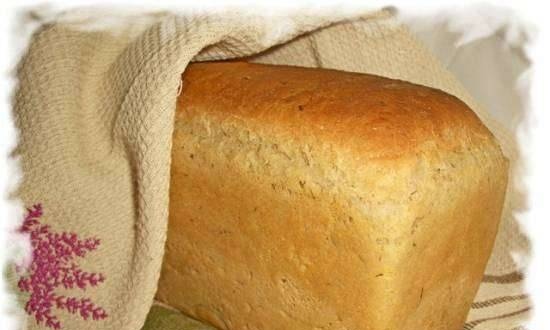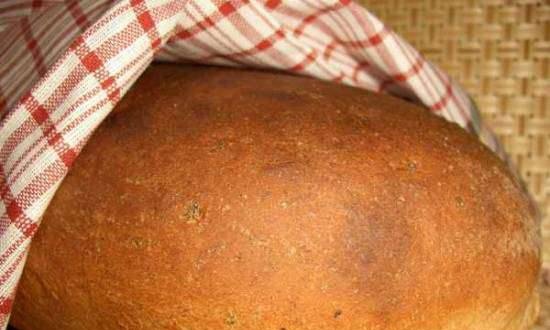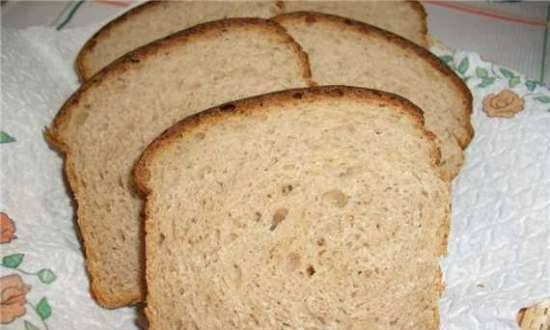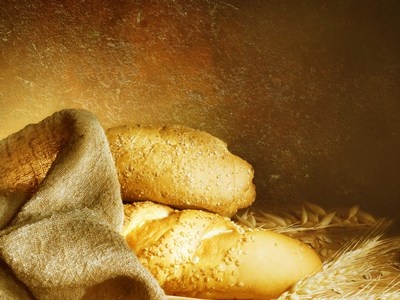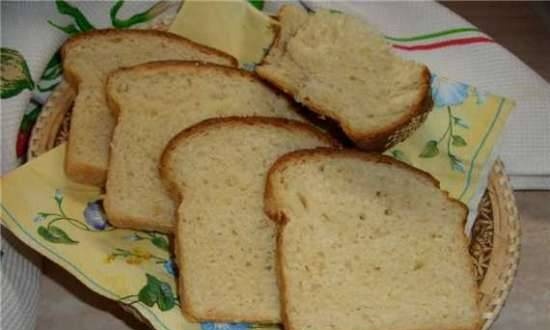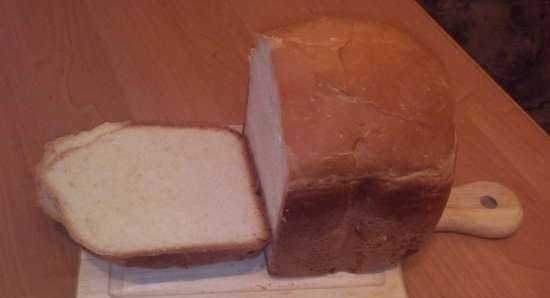|
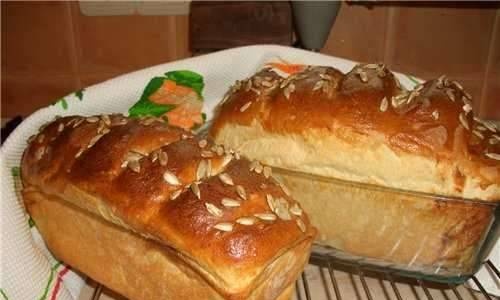 - Bread for a ballerina? - I ask again incredulously. - Bread for a ballerina? - I ask again incredulously.
- And for the ballerina - too. What surprises you? - Director of the Scientific Research Institute of the Bakery Industry Ruslan Vladimirovich Kuzminsky seems to understand my bewilderment, but does not want to share it. He smiles, but speaks seriously: - If we take the profession as a guide, then I will say: we are developing bread recipes not only for ballerinas, but also for miners, polar explorers, fishermen, geologists. I'm not talking about astronauts.
At the All-Union Scientific Research Institute of the Bakery Industry, the main scientific topic is bread, bread today and bread to be. Outwardly, it will remain the same: loaves, loaves, buns, loaves, flat cakes. And the bread will not taste very different from today's.
Improvement of bread will occur, and it is already happening, almost imperceptibly for the eater. One variety will be a little more satisfying, the other, on the contrary, will be less nutritious, the third - with vitamin supplements, the fourth - with milk whey ...
- It is for what is with whey that the name “ballerina's bread” has stuck among our employees, - the scientist continues. Why? The product is exempt from such components that make it contraindicated for those who should not or do not want to gain weight.
Acquaintance with the work of the employees of this institute convinces that the improvement of bread here is placed on a serious scientific basis. Gone are the days of empirical research when the baking oven was the main tool. Many of the baking technological regimes now adopted at bakeries were born in the laboratories of the institute. It was this new technology that solved the problem of how to give machine bread quality stability. The main difficulty was that with the current volumes of baking, it is impossible to achieve exactly the same composition of flour. Today there are more Mironovsky wheat varieties, tomorrow - Saratov or "Kharkiv". But even if wheat of the same variety comes from different regions of the country, the flour comes with noticeably different baking properties. Yes, and year after year is not necessary: now there is more moisture in the grain, then it is dried by the scorching sun. And the eater doesn't care much about this: give him the usual bread. It is for the preservation of this "familiar bread" that the technological regimes have been developed. Of course, it is too early to say that the work is over. Scientists are in no hurry with final conclusions and final assessments. Everything must pass the test of time, although they no longer doubt the correctness of the chosen methods and technologies.
As for new varieties of bread, they are created not in the name of novelty, but in search of the best combinations of taste and nutritional qualities.
“It is known that bread is one of the most convenient suppliers of proteins necessary for each of us,” emphasizes Ruslan Vladimirovich. - But there are not enough of them in wheat and rye flour. Therefore, tests were started to enrich the bread. It was quickly established that the best ratio between protein and carbohydrates was one to four. This "arithmetic" was recommended to bakers. Then it turned out that the soy mixture not only increases the amount of vegetable protein in bread, but also improves its quality. A small addition of fishmeal made the bread richer in animal protein, although it took a lot of tinkering to find a baking regime that would eliminate the fishy smell.
Now these breads are known under the names "smelt", bread "Caspian", "Amur". Not immediately, however, everything worked out. At first, wheat and rye seemed to rebel, showed disobedience. Bread did not come out, foreign protein was rejected.The loaves turned out to be unsightly, flattened, with torn edges. The buyer did not want to look at them. And no matter how they were advised or explained that this is very satisfying bread, they heard in response: “So eat it yourself for your pleasure. And we'd better take "Orlovsky".
For a long time, stubbornly and systematically, experiments were carried out, which were accompanied by theoretical research. And now the work is not yet fully completed. But regularities have already been traced that help not only to manage the baking of fortified bread. Now it is possible, though cautiously, but confidently to rearrange the "cubes" of the biological constructor. The basics of compatibility and incompatibility of various proteins are learned.
Several dozen sorts of bread, enriched with milk, dairy products and soybeans, are already being baked. And every year there is more bread with additives. A little over ten years ago, a million tons of it were baked. And now more than ten million tons of this kind of bread goes to the shelves. Almost half of the all-Union loaf!
Milk bread good, tasty, easy to digest. And the fact that now the very first varieties of it are baked - the first since the creation of such breads, chronologically the first - suggests that over time, improved bread will become even better. After all, time and the ongoing work of scientists promise to further polish and improve it. But bread is tested not only in laboratory conditions. Once they invited young and healthy, athletic guys - lumberjacks.
- Don't you complain about your appetite?
- And what will you treat?
- Bread.
We were introduced to the test program: for three weeks they will work, as usual, in the felling, and they will eat only bread.
- For a change - with tea. We'll talk about satiety later.
The guys agreed.
The experimental conditions were followed exactly. For breakfast, bread and tea, for lunch, tea and bread, in the evening they were given a "choice" - either tea with bread or bread with tea. So all the days allotted for the experiment.
They ate bread. Only one bread. And the feeling of hunger did not appear. And the state of health was normal. As if they ate the usual breakfasts, lunches and dinners.
Then they were told that they were fed bread with fishmeal and other animal proteins. Special varieties. Highly nutritious.
The Scientific Research Institute of the Bakery Industry is also working on varieties of bread with medicinal additives. With a high iodine content (when you see the sign: "Bread with seaweed", you know, this is it, iodine bread), sugar-free for diabetics, other varieties. New bread products in terms of their qualities, taste and aroma are close to the "ordinary" bread that has long shaped our tastes.
The institute has also developed an express technology for preparing dough. Its essence: flour, yeast, water, all components are introduced into the kneading chamber not in the same long-term sequence, but simultaneously with the concentrate of lactic acid sourdough. And serve the dough for cutting - the kneading takes only 3-4 minutes, and the dough ferments for no more than an hour. Then proof it and bake delicious express breads.
"Fast dough", "express bread"- these terms have become firmly established in the practice of baking. Already at many bakeries, dough is prepared in an accelerated way. And it’s not only the economic benefit, although it is noticeable — the introduction of new technology made it possible to save 180 thousand rubles annually — it became possible to quickly switch from one type of bread to another. After all, the whole process of preparing the dough takes no more than an hour and a half. In addition, at such "speeds" it is possible to raise the question of canceling the third, night, shift. In fact, with express technology, you can come to work in the morning, and after an hour and a half you can already roll bread and put them in the oven.
The development of new methods, new methods, in which the process of maturation of the dough is noticeably accelerated, is being carried out not only in our country. This is understandable.In different countries, among different peoples, making dough and baking bread require a lot of effort - strength. The baker does not leave the oven day or night. I just baked the bread, and the new dough came up. So the bakers of the world are striving for a new technology. At one time in the United States, the "kimber-winter" method was widely advertised - by the name of the drug introduced into the dough. In England, more than 60 percent of bread is produced according to the "chorleywood process" - this is both intensive mechanical processing of the dough and the ascorbic acid added to it. In Australia, you use ^, however, not very widely, a similar method "brimex". Another American name, "doo-mey-ker", is a batch on a fermented semi-finished product ahead of time. The bread is baked quickly, but there is no "full" aroma in it, as bakers say. Soviet bakers, introducing progressive technology, strictly monitor that the continuous and accelerated preparation of the dough does not spoil the bread. That is why at the last international meeting of bakers it was especially emphasized that the Soviet method is not just good, the technological processes used in the Soviet bakery industry in some cases exceed the level of world standards. The technology developed in the Soviet Union, in addition, excludes the very outdated mechanization of the type of bunkers, rolling bowls, troughs and other "novelties" of the beginning of this century. As a result, there is less manual labor at the bakery. And flour is used more sparingly. The savings achieved are 2 percent.
When you buy a fluffy white bun or a fragrant loaf of rye, you should know that not only bakers, but also scientists, bread designers, participated in its creation.
One of them is V.V.Shcherbatenko. For his work, he invented so many varieties and types of bread that, collecting them on one table, there will be an unprecedented feast. As I write these lines, I think: why not really collect all the varieties created by one person? Why not mention his authorship - a noble, beautiful, pleasant authorship for everyone. At the same time, say kind words, give a person a certificate: such and such created bread, which everyone eats and praises. Glory to the author! Thanks to him! And hand over a copy of the Quality Mark awarded to bread. And the bread itself would be awarded with a medal. Gold. And then there are so many of them, gold and silver medals, on wine labels. So a golden reflection with an alcoholic aftertaste sprinkles. Bread would be such an honor as is given in the world to wine!
We also talked about this at the institute, because scientists cannot but care about the situation in which bread suddenly (or maybe not suddenly) found itself. Little attention is paid to him.
At one time, the very fact of organizing the institute was regarded as an act of attention to bread. The newspapers wrote:
“Bread-making is rapidly becoming the forefront of the industrializing food industry ... The scientific and technical base for the bakery industry is the All-Union Scientific Research Institute of Bakery ... The Institute is located in the building of an experimental mechanical bakery, which, despite a number of inconveniences (high temperatures in some ), makes it possible to conduct scientific work in an industrial environment. "
At first, the scientists of the institute looked closely at foreign experience, foreign practice. In some bakeries abroad, the cooking process was already entrusted to machines. The British company "Becker Perkins", the German "Winkler" and "Werner und Pfleiderer", the Dutch "Denbourg" made such machines and advertised them intensively. The study of other units - the Swiss "buss", the English "tweedies" and "gilbert", the Czechoslovak "topas" - the scientists of the institute also carried out with sufficient completeness. We agreed: yes, the machines are reliable, efficient and easy to maintain. But the bread that people are used to in Russia cannot be obtained for them.
Our specialists, bakers and machine builders began to look for their own ways. And they found it. This book has already spoken about Marsakov's factories.At present, they have been replaced by new enterprises with an unprecedented productivity - 200, 300, and then 500 tons of bread per day. And bread is baked of such merits that there is no equal to it in the world. Austrian designer Roland Stumberger once said:
“And when they talk about Russian rye, it doesn’t fit the usual characteristics at all. This is the premier among the loaves! "
But the recognition of experts: "Bread products produced in the USSR, in terms of such important indicators as taste, aroma, appearance, are significantly superior to similar samples produced in many countries of the world" - came much later.
- Today the problem of machines and technology for preparing dough on quick starter cultures can be considered solved, - Ruslan Vladimirovich Kuzminsky noted.
The State Commission has accepted the new dough preparation units with high appreciation. They showed them to me. They make up a whole automated line for baking bread. At the end of the line, the finished bread is cut into slices and wrapped in foil at the factory. You bought, say, such a loaf, opened the film, took a chunk, two, as needed, and closed the remaining bread again. Such a loaf retains its freshness for a long time.
The automated line, consisting of forty machines and mechanisms, appeared as a result of long-term and good cooperation between the All-Union Scientific Research Institute of the Bakery Industry and the Institute for Grain Processing of the GDR. Incidentally, within the framework of socialist economic integration, the institute has established strong and effective relations with colleagues from many CMEA member countries. And every year they get stronger.
During the work on the creation of this automatic line, a replacement was found for an expensive and not very perfect mold lubrication.
The new coating is silicone. The bakers liked it immediately. The first organosilicon was used at the factories of Voronezh and Novosibirsk, and they immediately reported: bread became tastier.
And we managed to get considerable savings. One and a half rubles per ton of baked tin bread.
The institute is doing a lot of work to collect, study, and sometimes restore forgotten varieties of bread. So, thanks to the efforts of its employees, the Russian kalach found its second life. There was a time, it was believed that the secret of its production was lost. Everything seemed to confirm this assumption. They baked Kalachi, but they did not succeed. The former kalach was superbly good (it's not for nothing that the saying still lives on today: roll you will not lure! The most, therefore, a delicious dish). But now the masters - hand-held Kalashniks - have passed away, and they took away the secrets of production. And no matter how hard the practitioners fought, it was not possible to get the roll in all its glory. A simple roll seemed to come out, was similar to the previous ones, but a rich roll, or a canteen, did not work out in any way. Outwardly, everything seems to be so, but the expert will taste it - not that.
They found a secret and restored the famous Russian kalach in the laboratories of the institute. When the first test batch was baked, they invited those who remembered the taste of those old rolls.
- Seem to be?
- Highly. Eating ...
The institute developed a technology for processing stale bread and bread, which turned out to be substandard, defective. Found and transferred to factories methods of accelerated preparation of dough for bagels. During the tenth five-year plan alone, the institute developed 22 themes, two of which, as the most important ones, were included in the coordinated plan of multilateral integration measures of the CMEA member countries. In the problematic direction "Increasing the nutritional value of food products", which was included in the plan approved by the USSR State Committee for Science and Technology, the "bread part" was assigned to the institute.
They gave me a treat at the institute with "geological" bread, slowly stale. Not without caution, I broke the loaf I had baked a month ago. A brittle crust crunched, revealing a porous, elastic crumb.
For decades, bakers have been struggling with the problem of how to keep the bread soft and not let it get stale quickly.
Stale bread - A special topic.Stale bread leads to waste of the harvest. After all, even if they buy stale, they do not eat everything. From someone's hard hand, almost a rule has gone - until the store sells the previously received bread, it does not release today's fresh bread on the counter. And half-batons and weighty humps fly into the waste bin.
For a long time it was believed that it was impossible to prolong the life of fresh bread. His lot is to grow stale. But is it possible to delay the aging of bread at least for some time?
This is the problem scientists began to solve, knowing full well that from any moral, social, economic standpoint, it is worthy of the closest attention.
We remembered Vladimir Gilyarovsky and his lines about Filippov's cakes, which “in some special way, hot, right from the oven, were frozen, transported thousands of miles away, and just before the meal they were thawed — also in a special way ...” How? How? Scientists have answered this question. And they created a methodology and technology for freezing baked bread, making this method industrial, corresponding to the spirit of the times, the scale of current production. Indeed, annually, only the factories of the Ministry of Food and Industry of the country bake about 20 million tons of bread.
They advised me to go to one of the largest bakery and confectionery factories in the country. Here are built huge, each would include several trucks, freezers. Bread and other pastries are served here directly from the oven. Temperature - minus 18-20 degrees. The bread quickly gets cold and freezes. And then almost the same technology as described by Gilyarovsky. Research has shown that frozen bread after thawing is no different from freshly baked bread. But you can store it in the freezer for many, many days.
Freezers have their own future. They are now tightly bound to bread. Such chambers not only preserve the freshness of the baked bread for a long time. Freezers are now used by confectioners. It is known what the demand for cakes and pastries is during the holidays. How to satisfy him? It is impossible to bake the amount of sweets corresponding to the holiday demand at the existing facilities. And putting more machines and stoves is not smart. Indeed, the rest of the year they will be idle. Freezers help solve this problem. I ate a thawed cake and could not distinguish it from the one I just made. And connoisseurs far more than I could not find the difference.
Large-scale, large-scale works, noticeable in baking, characterize the present day of the Scientific Research Production Association of the Bakery Industry, which now includes the “Bread Institute,” as it is often called. They also do not overshadow minor concerns. Here we took the time to create a very convenient home breadbasket, develop packaging for bread, design bread containers that should replace the old trays, improve the same freezing breadlooking for new supplements.
Russian, Soviet baking is firmly associated with such luminaries of domestic science as D.I.Mendeleev, A.N.Bach, A.I. Oparin, with such prominent scientists and engineers as L. Ya.Auerman, N.F. Gatilin , N. P. Kozmin, V. L. Kretovich, F. G. Shumaev. Today, at the All-Union Scientific Research Institute of the Bakery Industry, their work continues and develops. In laboratories and in a pilot plant, the bread of tomorrow is born. The bread that we, our children and grandchildren will eat.
Barykin K. Bread that we eat
|
 - Bread for a ballerina? - I ask again incredulously.
- Bread for a ballerina? - I ask again incredulously.